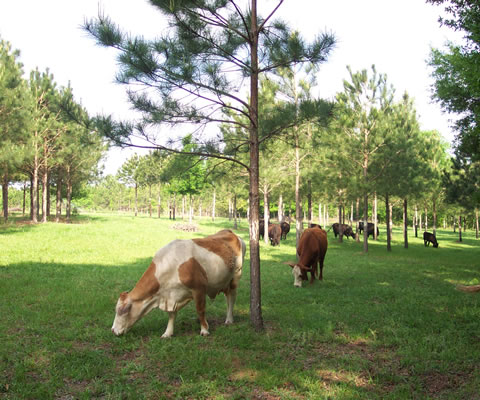Silvopasture is an agricultural technique in which livestock graze in an environment integrated with trees. Studies have shown that the inclusion of trees into the landscape can have profound effects on agricultural output and productivity. For instance, livestock in silvopasture display more optimized grazing as the presence of trees encourages grazing over a larger area of land. Trees provide shade for the livestock, resulting in reduced heat stress, which allows them to retain more energy throughout the day and overall be healthier and live longer. Foliage that falls from the trees onto the pasture can provide additional nutrients for the livestock as well as increase fertilization of the soil upon decomposing. Plus, the ingraining of tree roots into the pasture reduces the chances of soil erosion and increases nitrogen content through the introduction of nitrogen-fixing legumes found in the trees’ roots. Moreover, the trees increase water quality and biodiversity in the area. According to a new study, silvopasture offers still other benefits by helping to reduce the effects of climate change. The agricultural technique's application results in the release of lesser amounts of planet-warming greenhouse gases compared to traditional open pasture, without reducing soil productivity. The findings suggest that silvopasture could be a useful tactic in addressing climate change. See also: Agricultural science (animal); Agricultural science (plant); Erosion; Fertilizers and nutrient management; Legume; Nitrogen fixation; Soil

The study, led by researchers primarily at the University of New Hampshire, involved land-change experiments from regular pasture to silvopasture at two sites in New Hampshire and New York. Both pastures were divided into different plots of either open pasture or silvopasture. The silvopasture plots were created for the study by cutting down 50–60% of the trees, and leaving all the tree stumps, while adding or allowing growing foraging sources such as orchard grass and white clover. Dairy or beef cows were added. The researchers could not detect differences in air temperature or carbon storage. The research found that, compared to regular open pasture, silvopasture released less carbon dioxide and nitrous oxide (both greenhouse gasses) into the atmosphere. Importantly, silvopasture retained the same amount of soil carbon content for agricultural productivity as regular pasture. See also: Beef cattle production; Carbon dioxide; Clover; Cover crop; Dairy cattle production; Forage crop; Global climate change; Nitrogen oxides
The study reported that although farmers have generally shown interest in the silvopasture technique, new adoption of the practice has remained limited because the current baseline level of adoption data is low, and thus, insufficient data have been available to guide implementation. While its benefits have continued to be borne out, silvopasture does entail more regular management compared to traditional open pasture. For instance, rotational grazing must be implemented in silvopasture to ensure minimal damage to trees by overgrazing. Nevertheless, the new study finds silvopasture to be an effective agricultural practice overall, and with concerns over environmental degradation and climate change likely to continue to grow in urgency, silvopasture may see increased adoption in the decades ahead.





